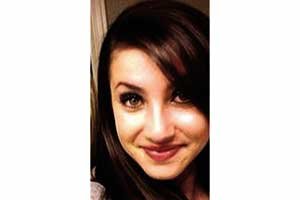Classmates of a 15-year-old Gilroy High School girl who died
over the weekend of possible alcohol poisoning will miss an
outgoing, gregarious friend, but are taking the opportunity to
think twice about their own drinking habits.
Classmates of a 15-year-old Gilroy High School girl who died over the weekend of possible alcohol poisoning will miss an outgoing, gregarious friend, but are taking the opportunity to think twice about their own drinking habits.
“People should look at this as a wake-up call,” said Evan Pomin, boyfriend of Sarah Botill, the independent studies student who died Saturday morning after consuming vodka at a sleepover with her friends. “Anything can happen.”
Pomin, 15, said he dated Botill on and off since eighth grade. The two were involved in the same youth group at South Valley Community Church. Pomin said he does not and has never drank alcohol.
“I loved her,” he said Monday morning at GHS. His teacher, Nicki Anagonston, stood next to him for support as they waited for Pomin’s mother to pick him up. “She will be missed.”
Pomin said he did not know where Botill and her friends got the alcohol and didn’t find out about the events of the night “until she was already gone.”
After exchanging a few quiet words with Pomin and his mother, Anagonston walked back to her classroom, tightening her coat against a brisk wind and dabbing her eyes.
“I’m at a loss right now,” she said. “Sarah was a pleasure and her parents were a pleasure to work with. We all love her very much.”
Anagonston met with Botill Friday for a weekly one-on-one meeting that independent study students have with their teachers. The program is housed in a portable building on the GHS campus and includes 56 sophomores, juniors and seniors this year, said office coordinator Nicole Nielsen.
Independent study students pick up their school work once a week and complete the bulk of it at home. They are required to complete the same number of credits as mainstream students and graduate with a GHS diploma, she said.
Students choose the alternative program for a variety of life circumstances and must be self-motivated in order to stay on track, Nielsen said. Some students are teen mothers while others have to work during regular school hours to support their families, but Botill did not fall into either of those categories, Nielsen said. Anagonston said Botill’s placement in Independent Studies was only temporary.
“She was a good student, very cooperative and easy going,” Anagonston said. “She never referenced any kind of partying. She was very open with me about the things she would do.”
Botill was close with her parents, who were “very involved in Sarah’s life,” Anagonston said.
Classmates were stunned to hear the news of her death, which spread quickly via text messages and over social networking Web sites, such as MySpace.
“Today was kind of a gloomy day at school,” said Becky Quehl, 15, a sophomore at Christopher High School who knew Botill from GHS last year and knows Botill’s older brother. “I talked to a lot of kids about it and they said they’re going to think twice (about drinking) in the future. For the kids who have (consumed alcohol) before, it really hit home because it could have been them.”
Many GHS students agreed that it doesn’t take much to get alcohol, saying they could get their hands on a bottle by swiping it from their parents’ house or asking someone outside a liquor store to purchase it for them.
Although GHS Principal Marco Sanchez said he never met Botill, her death hit particularly close to home for him because he has a daughter her age, he said.
“It’s very tragic and my heart and prayers goes out to her family,” said Sanchez.
He was not aware of any memorial service or vigil planned for Botill but an extra psychiatrist was on campus to counsel grieving students today, he said. Teachers were advised to direct any students showing signs of grief to student services, Sanchez said. After the holiday break later this month, juniors and seniors will give presentations to the younger grades on the dangers of alcohol as part of a peer-mentoring health class. Every freshman also learns about drugs and alcohol in their physical education classes, Sanchez said.
Despite these classes, “we know kids don’t always make healthy choices,” Anagonston said. “Anytime there is a tragedy, we ask students to really think about what they can learn from it.”
Anagonston hopes students will “have the courage to speak up and step in when they see their friends doing something risky,” she said.
“They think it’s harmless fun and it takes a tragedy to get them to see this type of behavior is not harmless,” she said, dabbing at the tears that slid down her cheeks with a crumpled tissue. “As sad as this is, it does bring awareness to something that is so readily available. We can’t deny or ignore that it’s out there and in extreme cases like this, students pay with their lives.”













